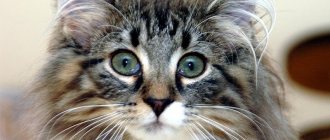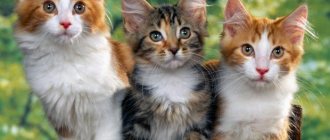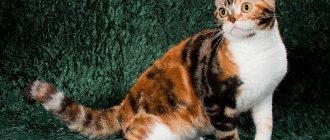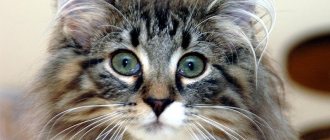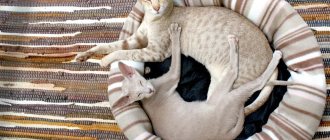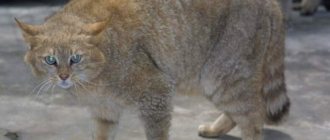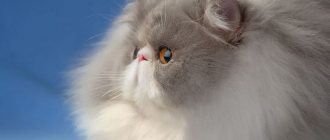History of the origin of the breed
Large cats appeared in Siberian forests around the 16th century. The nomadic peoples who inhabited these territories did not need mousecatchers. Therefore, there are two assumptions about how the animals ended up in Siberia: they were brought either by Central Asian merchants or by settlers from the western Russian regions.
Probably, the brought pets began to mate with forest cats, which resulted in offspring with luxurious, warm fur.
Interesting! For a long time, the Siberian cat was considered a variety of the Norwegian forest breed. This is how she was presented at exhibitions.
Selection work began in 1986. Large cats with thick fur were first called “Moscow”, but later they realized that the epithet “Siberian” was more suitable for them. In 1989, the breed became officially existing, and in 1990, a breed standard was drawn up. In 1992, “Siberians” were recognized by the international felinological organization WCF, and in 1996 – by CFA, TICA.
In 1994, the first world champion was a representative of the Siberian blue breed - the cat Dimka. In 1997, the breed standard was supplemented with characteristics that finally separated the “Siberians” from the Norwegian cats.
The history of the appearance of the Siberian cat breed
Pets with the characteristic features of the Siberian cat have been mentioned since the 16th century.
The breed appeared as a result of crossing a domestic pet with a wild cat.
In the 90s the breed became official.
Siberian cat.
Siberian cat.
Siberian cat.
Siberian cat.
According to one version, this breed appeared as a result of crossing a domestic pet with wild cats. Settlers in the Trans-Urals did this in order to produce offspring that had characteristics better than those of their parents.
In the 90s, this breed was declared official in the USSR. Scientists have defined what a Siberian cat should be like, what its character traits and characteristics are. Since then, this breed has gained fame in America and Europe. The Siberian cat captivated the inhabitants of these countries, and they called it the best breed in the world .
Description of the breed standard
Siberian blue cats look impressive and luxurious. They are large anatomically, but their lush fur gives them even more volume. Females weigh less than males, the weight of the former is 4–7 kg, the latter – 6–9 kg.
Breed standards:
- The muzzle is wide, trapezoidal with rounded features. The angle between the nose and forehead is smooth but noticeable. The cheeks are voluminous. The chin is pronounced, but not massive or protruding.
- The ears are medium. Slightly tilted forward. The ends are rounded and decorated with small tassels.
- The eyes are large and oval. The look is penetrating and serious. The color of the iris is not determined by the color of the coat, most often green and light brown. White kittens with blue eyes are often born deaf.
- The body is slightly elongated. Muscle mass is developed. The neck is short and muscular. The chest is wide. The back of the back is slightly higher than the front. The belly is round, not saggy.
- Limbs of medium length. The paws are round and large. Short hair grows between the toes.
- The tail is of medium length, tapering from base to tip.
- The wool is lush, shiny, and almost impervious to moisture. The undercoat is delicate but dense. The guard hairs are more rigid.
The length of the coat of Siberian cats is not the same in different seasons of the year. In the warm months, only the tail is bushy; in winter, “pants” grow on the hind legs, and a “collar” grows on the neck.
Breed description and photo
A cat of this breed is unlike others; it is distinguished by: a large build and muzzle, fluffy and thick hair, character and physiology. So that you can always distinguish a Siberian cat from some others, you need to take a closer look at this breed.
The Siberian cat has a large build and muzzle.
Wool
Siberian cats have medium length fur and medium fluffiness. The coat grows thickly and has a good undercoat.
Siberian cats have medium length fur.
A breed with fluffy fur.
Cats have thick fur.
In summer, wool is thinner.
Cats' fur is water-repellent.
Cats have thick fur around their faces.
This breed is prone to shedding like other breeds, so the coat is thinner in the summer and denser and thicker in the winter. To the touch, the wool can range from the softest to the roughest. In addition, scientists have proven that the fur of Siberian cats has water-repellent properties.
Siberian cats are clearly distinguished by fluffy pants on their paws and thick fur around the face or a fluffy collar.
Color
The Siberian cat has many types of coat colors. It can be one-color, two-color, or have three or more colors. There are no colors of cats: brown, purple and blue.
Siberian cats have many types of coat colors.
Some breeders crossed the Siberian cat with the Persian , in the hope of obtaining an interesting color color. The crossing was successful, but the offspring's coat lost important characteristics inherent in Siberian cats.
External features
Cats have a large head.
The neck is short.
Ears with beautiful tassels.
Siberian cat.
Paws of medium length.
The eyes are oval shaped.
- The head of Siberian cats is quite large, but this does not prevent it from looking proportionate with the body.
- The neck is short but powerful.
- The ears are wide and rounded at the end, with beautiful tassels that they inherited from their predecessors.
- Oval-shaped eyes can be green, yellow and blue.
- Paws of medium length.
- There is abundant fur between the pads on the paws. The tail is medium.
Weight
Cats of this breed are quite large in size . An adult cat can reach up to 6 kg, and a cat up to 12 kg. But since Siberian cats grow very slowly, they will gain their maximum weight only by the age of 5.
An adult cat weighs up to 6 kg.
Reproduction
Puberty in this breed occurs early, at approximately 5–7 months.
This property was passed on to them from their ancestors. Wild cats did not live long in Siberian conditions, so they tried to leave offspring as early as possible. Pregnancy in cats goes smoothly, 5-6 kittens are born.
A Siberian cat gives birth to 5-6 kittens.
Possible deviations
Siberian blue cats are not allowed to participate in exhibitions with:
- an elongated and puny body, a thin skeleton, long limbs and neck;
- narrow, high cheekbones, flattened muzzle with a sharp chin;
- small, round eyes deeply sunk into the skull;
- large or small ears located close to each other;
- short or long tail, not fluffy enough;
- weak or absent undercoat;
- not shiny, tending to get tangled with guard hairs;
- hairless indentations between the toes.
Siberian blue colors
The advantage of the Siberian breed is its many colors. There are more than 200 color variations of wool.
Solid
There are 2 solid colors of the Siberian cat:
- solid black – black;
- solid red - red.
Often there are individuals with the color solid blue - a variation of black with a blue tint, as well as solid cream - light red, fawn. Spots of other colors with a solid color are unacceptable.
Tabby
More often there are Siberian cats with a patterned color, for which the following are required:
- light spots around the eyes;
- chin white;
- "M" pattern on the forehead;
- longitudinal stripes on the back;
- ring-shaped striping of the limbs and tail;
- stripes in 2 or 3 rows on the neck;
- 2 rows of small spots on the belly.
The Siberian cat has the following spotted colors:
- Brindle – striped. A wide stripe runs along the back, and narrow stripes go along the sides of the body.
- Marbled - symmetrical spots on the sides of the body. There are 3 stripes along the back.
- Spotted - round or oval spots of regular shape with clear edges cover the entire body. There are Siberian cats with black, blue and red spots. As well as a tortoiseshell variety - tri-colored.
Other
In addition to the above, the following colors of representatives of the Siberian breed are found:
- Chinchilla is a rare color in which each hair is two-colored: most of it is light, and the tip is dark.
- Smoky is a color in which the base of the hair is unpigmented and the tip is colored.
- Silver – white undercoat, gray guard hairs and dark pattern.
- Golden color with a pronounced pattern.
- Color point - the muzzle, tail, ears and paws are darker in color than the rest of the body. Representatives of the Siberian breed with this color are called Neva masquerade cats.
Siberian blue cat
Another variety of this breed is the Siberian blue cat.
- This breed has a medium-length coat with an undercoat.
- The coat color is not as varied as that of an ordinary Siberian cat.
- Blue Siberians have a gray, almost ash color with a blue tint.
- The color of the coat is uniform and has no patterns.
- The size, features of the breed and character are the same as that of a simple Siberian cat.
The Siberian Blue cat breed is gray in color with a blue tint.
In Russia, this breed became famous in the 19th century.
Although this breed was bred here, it was more popular in Europe. We were skeptical about the Siberian blue cat because of its ash color. It was only after the 1980s that blue Siberians gained universal recognition and began to enjoy popularity in our country.
Pros and cons of character
Siberian cats are smart, quick-witted, calm, balanced, and friendly. Sanguine by temperament. They are diplomatic towards people: they love affection, but can show character if they are persistently squeezed. Strangers are treated with distrust and tension.
“Siberians” are serious, moderately proud, and do not need constant attention from their owners. They understand when the owner is busy, they don’t interfere, they don’t interfere with work and rest. But a cat also requires a respectful attitude towards itself.
The Siberian pet becomes attached to one person, but is friendly towards other family members. He gets along with the non-aggressive animals living in the house, but he will bravely fight back the aggressor, be it a person or an animal. In terms of protective qualities, it is not inferior to dogs, it warns with meowing about the approach of an enemy, and rushes into battle if the owner is in danger.
“Siberians” are loyal to children, but do not allow themselves to be made into living toys. If a child becomes spoiled and begins to mock the pet, he will immediately be bitten or scratched.
The hunting instinct of Siberian cats is stronger than that of many dog breeds. The muscular and jumping pet easily attacks mice, rats, birds, and even large ones.
Attention! You should not leave a hamster or parrot with the Siberian. The cat will perceive the small creature as a victim.
Siberian cats are excellent steeplejacks. They like to sit somewhere upstairs, watching what is happening below. In terms of games, they are easy-going, willingly play with any object offered by the owner.
Character of the Siberian cat
Cats have an independent character.
Siberian cat.
Siberian cat.
Siberian cat.
Siberian cat.
Not lazy.
The Siberian cat has an independent character and does not tolerate unexpected affection from its owners.
Despite their character, cats of this breed are very affectionate, kind and sensitive. If you do not force your affection on her and take her opinion into account, then she will become an excellent friend for you. You can play any active games with such a pet; they are not lazy and unpretentious.
Breed Features
In addition to its strong character, the Siberian cat has a number of features that elevate it among other breeds:
- Superb instinct . This cat is a good hunter. She can easily catch a mouse or even a rabbit. This breed can survive even in the most extreme conditions.
- Lack of fear . Siberian cats are not afraid of dogs, people and various noises that ordinary pets avoid. Animals of this breed are owners. They guard their home and hiss at strangers who disturb their peace.
- Easy to learn. These cats are very smart and have a good memory. At an early age, they easily learn to use a toilet and a place to sleep.
- Love of heights . Siberian cats love to climb to the highest places in the house. She can sit on a cabinet or refrigerator. This is explained by the fact that this way it is better for the Siberian cat to observe its space.
- Lifespan . Cats of this breed have excellent health and excellent immunity. They are not affected by many diseases that affect pets of other breeds. Such cats live on average 15–20 years. Cats can give birth up to 18 years of age, and males up to 12 years of age.
Cats have excellent instincts.
A good hunter.
Cats have no fear.
Easy to train..
Smart cats.
They have a good memory.
Health and illness
The lifespan of Siberian blue cats is 18–20 years. Representatives of the breed are in excellent health.
In rare cases, older cats develop:
- pathologies of the digestive tract;
- renal failure;
- diseases of the heart and blood vessels.
These diseases should be treated by a veterinarian.
Attention! Golden Siberian cats are susceptible to hypertrophic cardiomyopathy.
The most dangerous pathologies of Siberian cats are kidney stones and the formation of a hairball in the intestines. Advanced urolithiasis causes kidney failure. The hairball usually comes out in vomit. To make this happen faster, an adult cat should be given a large spoon of sunflower oil, and a kitten should be given a teaspoon.
Don't forget about annual vaccinations. When carried out in a timely manner, it protects the animal from fatal infectious pathologies: calcivirosis, rabies, rhinotracheitis, panleukopenia, chlamydia.
Breeding and mating
To select a male for a female, you should contact specialists working at exhibitions. They will show the exhibition catalog and point out the advantages and disadvantages of the presented individuals.
2 weeks before mating, your pet should be treated for worms. The day before mating, trim the claws. The female is taken to the male, and they take with them a bowl, tray, and bed so that the cat does not feel uncomfortable visiting.
Animals are left in a cozy and warm room. You can pick up your cat in 1.5–2 days. After a month, signs of pregnancy will become noticeable. The Siberian cat usually gives birth to 5–8 cubs.
Care
The Siberian cat is distinguished by its cleanliness and accuracy. Her lush coat requires careful care.
Wool
Although the coat of the Siberian blue cat is dense, it is not susceptible to the formation of tangles. Therefore, brushing once a week is sufficient. But during shedding, you have to scratch your pet every day.
Combing requires a wide brush and two combs - with frequent and rare teeth. The combing procedure begins with a sparse comb, then moves on to a tool with frequent teeth, and ends with a brush.
Scratch the “Siberian” in the direction of hair growth. After the procedure, the hair is fluffed up by making several movements with the brush against the growth of the hairs. You should not bathe a Siberian cat more than twice a year. When the animal returns from a walk, you should wash its paws.
Ears
The cat's ears are checked weekly. They should not be red, foul-smelling, or emitting any discharge. Clean the inside of the ears with a cotton swab moistened with veterinary ear lotion. You cannot wash them, otherwise inflammation cannot be avoided.
Eyes
Siberians' eyes are not prone to watering. Therefore, it is enough to periodically wipe the teardrops with a moistened, lint-free cloth.
Claws
Siberian cats do not have their claws trimmed; natural hunters painfully experience the procedure of depriving them of their hunting tools. The pet gets accustomed to the scratching post without any problems.
Walk
To feel good, a Siberian blue cat must definitely walk outside the house and exercise its hunting instinct. Before a walk, the cat is put on a flea collar. The pet is brought out on a leash, although some freedom-loving “Siberians” do not like such an accessory.
The Siberian cat is not afraid of frost, so you can walk with it even on cold winter days.
Care and maintenance
Caring for a Siberian cat is very simple if it is kept in a private house in nature. In such conditions, the pet lives at ease and takes care of itself. When living in an apartment, long-haired pets need to be brushed regularly once a week. During shedding in spring and autumn, you need to remove dead hair daily. The entire procedure for caring for and maintaining a pet comes down to traditional simple manipulations:
- With regular brushing from a very early age, the animal gets used to it, and the kitten may even like it. The fur of Siberians has the property of not matting or matting, so painful sensations when combing can be avoided. To do this, purchase a wide flat brush with a double-sided purpose, a comb with rare teeth, it is best to use a furminator.
- While still in the nursery, the kitten quickly learns to use the litter box. The container should be wide and deep, because Siberians grow to enormous sizes. To prevent the filler from clinging to long hair and fluffy paws, it must be large and hard, and most importantly, clean.
- You should not bathe your cat, only after a walk wash and dry its paws and wash its organs. The only exception when special care is required for a Siberian cat is when walking outside; you need to wash your paws after each walk. To wash and eliminate cat odor, use a special dry cleaning powder.
- For domestic cats, the hair between the toes is trimmed to make it easier to keep their paws clean.
- Regular use of malt paste will help remove hair (trichobezoars) from the stomach, which accumulates during licking.
- Once a month, clean the ears from dirt and wax with sanitary sticks carefully moistened in an antiseptic solution without alcohol and clean the eyes with a damp cloth if there is discharge.
- Siberian cats do not have their claws cut; it is enough to have a scratching post. To provide your pet with a comfortable place to play and relax, purchase a multi-level complex with a scratching post.
- For summer walks, the wool is treated with special products against fleas and ticks, and a collar impregnated with parasites is worn.
Siberian cats video
Important! For people suffering from allergy attacks, it is advisable to check the reaction to the allergen from fur and sweat before purchasing a Siberian cat.
Diet
Feeding Siberians at home is not difficult. They are descendants of animals raised in nature and prefer simple, varied food. Breeders and veterinarians advise feeding your pets using home-cooked food from a varied selection of natural products. Which should include:
- Lean meats and poultry, rabbit, pork should be excluded. The products are frozen, chopped and given to animals at the rate of 70 - 100 grams per day.
- By-products from poultry and meat such as: heart, stomachs, udder, liver, tripe are boiled, ground and normally 70 - 100 grams per day alternated with meat.
Important! Liver is offered to light-colored cats only twice a month.
- 4. Low-fat cod fish (hake, cod, pollock) are boiled and boneless in the amount of 50 grams twice a week.
- Chicken quail eggs are boiled and mixed with meat along with the yolk 1-2 times a month.
- Be sure to give fermented milk products 2-3 times a week: sour cream, kefir, cottage cheese, exclude whole milk.
- Porridges from various cereals in water, including beans, peas and lentils boiled to a puree consistency, add 50 g to the meat.
- Boiled or chopped raw vegetables and herbs are added at least 1-2 times a week.
- Place a large bowl of clean bottled water next to your pet's food.
Important! Be sure to add a vitamin complex to your food daily on the advice of your veterinarian.
When feeding your pet, follow simple rules:
- food at room temperature is given at the same time in one familiar place, the dishes are kept clean;
- feed an adult cat 2 times a day;
- the volume of food should correspond to approximately 30–60 g per 1 kg of cat weight;
- The food composition must contain at least 60% proteins, 30% carbohydrates and 10% fats; this is a sufficient amount of nutrients, plus vitamins and minerals.
If necessary, a Siberian cat can be switched to ready-made factory food. But it is selected according to the age and physiological state of the pet. Food must be premium and super-premium.
Health and diseases
The Siberian cat breed has good health; the descendants of those raised in the natural conditions of the harsh climate of Siberia, they do not have a predisposition to colds and genetic diseases.
For their development and growth, the main thing is to maintain a proper balanced diet and maintain minimal care and maintenance. With timely vaccination and helminth prevention, there are no major threats to the health of Siberians.
In cats, hair can get into the intestines.
Problems usually come with age:
- with the gastrointestinal tract, caused by poor digestion;
- with heart disease, shortness of breath, slowness, lethargy, and cough appear;
- Urolithiasis often leads to kidney failure.
Important! When the first symptoms of disease appear, it is recommended to seek advice and treatment from a veterinarian.
How many years do Siberian cats live?
Large and well-developed cats of the Siberian breed have fairly good immunity, inherited from their ancestors who lived in the harsh taiga climate. Kittens mature up to 5 years old, but in general the breed is considered to be long-lived compared to other cats.
The average lifespan of a Siberian cat can reach 17-20 years, but with proper care and a balanced diet they can live 20-25 years. This is explained by the lack of hereditary, genetic predisposition to certain diseases.
Important! The life expectancy of a Siberian cat is well influenced by care for the psycho-emotional state of the pet and the attention of the owner and family. They show love, affection, and involve the pet in active joint games.
What to feed a Siberian cat
Representatives of the Siberian Blue breed eat with appetite everything that is offered. But it is advisable to feed them not with store-bought food, but with natural food.
The diet includes:
- raw and cooked meat;
- boiled fish and seafood;
- offal;
- eggs;
- goat milk, low-fat cream, fermented milk products;
- cereal porridge.
“Siberians” do not have a tendency to have an allergic reaction, but some individuals may be intolerant to lactose and chicken meat.
Liver should not be given to a cat with light fur often. Otherwise, the guard hairs will darken.
Rules for choosing a kitten
A Siberian blue kitten should be purchased from a cattery or at an exhibition. You should not make a purchase with your own hands: there is a high risk of purchasing a sick or outbred animal.
A healthy kitten is selected based on the following characteristics:
- lively, timid, non-aggressive behavior;
- absence of bald spots, dandruff, traces of parasites;
- shiny coat;
- clean eyes and ears;
- moderate fatness;
- clean anal opening.
They are buying a 3-month-old kitten. By this time, he is already accustomed to the tray and scratching post, and vaccinated.
Price
The seller must provide the buyer with a vaccination card and pedigree of the kitten.
The cost of a kitten is determined by the class and rarity of the color. A pet-level pet (companion) will cost 10–30 thousand rubles. An animal of the breeding category (for breeding) – 30–60 thousand. For a show category kitten you will have to pay 60 thousand rubles.
Care in the first months of life
The first months of a kitten's life in a new home are stressful. Until the pet has adapted, its diet cannot be changed. You should give him his usual food. The change in diet should be gradual.
At the time of purchase, the kitten is not always accustomed to the tray and scratching post. We have to teach him. The owner must be patient, not scold the pet when it defecates and sharpens its claws where it is not supposed to, but gently show it where to do it.
Two weeks after purchase, the kitten is introduced to a comb and brush and taught to wash its paws. This should not be delayed, otherwise the pet will constantly be capricious during grooming procedures.
Kittens
The character and appearance of the purchased kitten depends on the breed. Babies from Russian-Siberian cats grow large and already at 3 months they demonstrate the basic standards of the breed.
Siberian kittens at this age look well-fed, active and curious. Baby's fur is still soft, but already shiny, his eyes are well open, and his ears, nose and anus are free of discharge. A healthy, vigorous and cheerful kitten in your arms feels calm, does not break out and responds to affection, and behaves friendly.
It is not recommended to pick up a kitten from advertisements without original documents confirming the pedigree. You can buy a purebred baby, and even one with genetic abnormalities.
Only in an officially reserved nursery can you purchase a guaranteed Siberian kitten, with a pedigree and a note in the passport about the vaccination.
Important! If, when buying a Siberian, you just need a pet, and not a show kitten and breed classes for exhibitions and breeding, then you can have a pet with slight deviations from the standard and not overpay for status.
Breed cost
The Siberian cat breed is valued depending on its pedigree, type of coat color or gender. Female cats have a higher price than male cats. It is of great importance where and under what conditions to buy:
- scammers often sell non-purebred fluffy kittens as Siberians at a fairly low price of up to 2000 rubles ;
- in the nursery, pet class kittens not intended for breeding cost from 5,000 rubles and above ;
- The cost of a Siberian breed and show class cat is much higher and depends significantly on coat color and costs from 7,000 rubles
- Golden, chinchilla color of purebred kittens with a pedigree can cost up to 35,000 rubles
Nurseries
The breed of Russian-Siberian cats in Russia is bred not only in the famous centers of Moscow and St. Petersburg. More than a hundred nurseries have been created in the cities of Saratov, Yekaterinburg, Krasnoyarsk, Petrozavodsk and others. Breeders do not stop in the formation of the Russian cat breed. They are faced with the task of not only preserving the large size of the Siberian, but also strengthening the quality of rare colors.
List of nurseries specializing in breeding Siberian cats:
“Russian Diamond” / Russian Diamond, Moscow.
Contacts: phone: +7-985-991-5009, Inna
WhatsApp: +79859915009,+79039616269
Website: https://sibcat-rd.ru/home-15
"Manchzhuri", Voronezh.
Contacts: Natalya Khomyak tel. +79204064506 (breeder)
Skype: khomyaks
“Property of Siberia”, Krasnoyarsk.
Contacts: Tsaplina Larisa Vladimirovna; +7(963)191-77-22
“Moon haze” - Moscow, Moscow region, Yaroslavl.
Contacts: Maria +7 903 581 3771 (WhatsApp)
“Forest Tale” – Republic of Belarus, Minsk
Contacts: Phone: +375-29-155-75-08; +375-29-576-43-28 (+ Viber for this number)
Facebook page: https://web.facebook.com/profile.php?id=100010691861495
Email address, [email protected] ru
